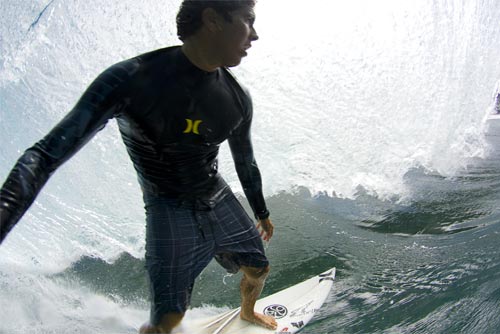IN MOTION: WAIMEA GAUNTLETS
Title: WAIMEA GAUNTLETS
Words: Trevor Spring

Waimea Bay Surfing - North Shore Hawaii
"When in Rome…do as the Romans do." When this old saying is used now, it often refers to going with the flow and following the behavior of locals while visiting a new place. In this case, we’re referring to the ocean devotees and lifeguards living healthy lifestyles year-round on the North Shore of O‘ahu. Here smack in the middle of the "seven-mile miracle" lies the legendary Waimea Bay.
During the winter months, the majority of the population of the North Shore can be found playing in the large surf created by the intense storms in the North Pacific. When these waves find a termination point on the North Shore, some of the biggest can be found at Waimea, which literally means "Red Water" in Hawaiian. This stems from the color of the river running to the ocean from the back of the Waimea Valley. With the ancient remains of Pu’u o Mahuka, an important heiau (Hawaiian temple), overlooking the shoreline, Waimea Bay has always held an eerily significant place in the world of big wave surfing. During the winter months, the most fearless watermen and women are found pushing themselves outside their comfort zone and paddling into the twenty-to-fifty-foot behemoth waves off the point.
During the calm summer months, however, the bay functions as a training ground for these adrenaline junkies and virtually everyone else looking to stay fit and balanced without setting foot in a gym. "Waimea is the North Shore’s swimming pool," says Bodo Van Der Leeden, captain of the North Shore District of City and County Lifeguards. "And if anyone plans on challenging the big surf on the North Shore, they had better plan to prepare their mind and body with plenty of running and swimming during the summer months. These run/swim workouts, otherwise known as gauntlets, make up the backbone of any waterman’s workout regimen here in Hawai‘i." The focus is on lung capacity, full-body strength, swimming proficiency, and retaining mental clarity while stressed for oxygen underwater.
A gauntlet has no strict format; it can be any duration, course, or intensity. The most common course at Waimea is to run on the soft sand from the east side of the bay toward the "jump rock" on the other side. Once across, charge into the water with no rest and swim back to the other side. Repeat as many times as you can handle. The bay is a couple of hundred yards across, so this course can be particularly challenging if the pace is kept up. For a faster pace and more interval-based workout, take two minute rests between laps. With this approach, you’re guaranteed to get more work done and build speed.
A common, but risky, attraction at Waimea is the rock jump at the west end of the bay. At about twenty feet, it’s not the height of the jump, but the shallow water and overcrowded conditions that pose the greatest risks. Although the lifeguards discourage it and post signs detailing the dangers, many beach-goers continue to climb the rock and line up for a turn to bomb off the top. "It’s an exciting thing to do, but we’ve had quite a few people get hurt doing it," says Captain Van Der Leeden.
In addition to the dangerous rock jump, swimmers should be aware of fishing lines near the beach. Van Der Leeden recommends "swimming out thirty-to-fifty yards before swimming parallel to shore when doing your workout. This time of year marks the beginning of the annual spawning of the hahalalu, a sardinelike fish that attracts bigger fish, which attracts the fishermen." As seasons and conditions change often, "The best approach is to simply ask one of our friendly, experienced lifeguards. We’re there from 9:15 a.m. to 5:15 p.m. ,seven days a week, and you can find out information regarding currents, jellyfish, or anything else you may want to watch out for,” says Van Der Leeden.
When parking, there is plenty of space right at the beach. If this lot is full, there is parking further back in the valley at the Audubon Center. From there, it’s a nice, scenic walk or warm-up jog down to the beach.
After your session of surf dashes, swim strokes, and sand sprints, you’re sure to be hungry. Check out Waialua Bakery in the historic town of Hale‘iwaIt sports a variety of specialty breads baked on the premises, big healthy sandwiches, fresh juices, smoothies, and vegetarian specialties. Waialua Bakery is right next to the Malama Supermarket at 66-200 Kamehameha Highway, and it can be reached at (808) 637-9079.
The bay is such a beautiful, scenic, and historic place that it is easy to simply sit, observe, and take it all in. That’s fine too, but why not sample a taste of the morning ritual of those locals lucky enough to live close to the "North Shore’s swimming pool"? Hope to see you on the beach. Aloha.
For more information on ocean conditions and directions, call the Ocean Safety and Services Division of the City and County of Honolulu at (808) 922-3888.

89a41438-2830-4f8f-820f-662ea0259b9e|0|.0